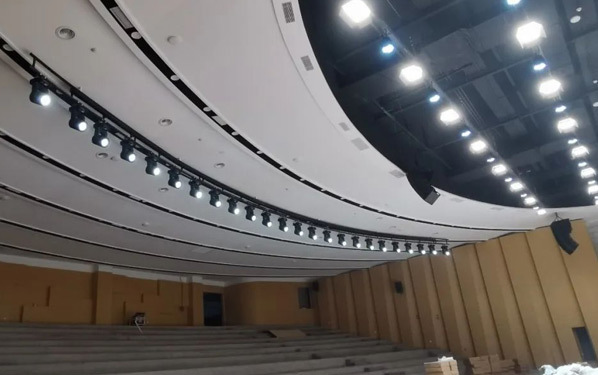How to judge whether the power amplifier is good or bad
2024-07-11
How do we judge the quality of audio amplifiers? Today, Shanchuan Audio Editor will give you some suggestions so that you will no longer have headaches and troubles when facing such problems.
First, many people think that the heavier the amplifier, the better. Inferior amplifiers all use toroidal transformers, and many use feverish double-ring transformers. However, the silicon steel sheets of this type of toroidal transformer are of poor quality, and the winding process is not up to standard. This results in low efficiency and low actual power, especially when it is quiet, it is easy to hear the toroidal transformer "humming".
Second, it is to charge imported Shanchuan audio brand capacitors with large domestic capacitors with small capacity. Some manufacturers even use the backlog of early capacitors to update the packaging and install new capacitors. The actual withstand voltage and capacity of these capacitors do not reach the rated value at all. This type of capacitor is generally lighter than the genuine product.
Third, it is to charge 5532 and other mid-to-high-end amplifiers with 4558 or 082. Sometimes it is found that many so-called 5532 are actually polished from 4558. There are also the most fakes of domestic amplifier tubes charged with imported tubes, especially Toshiba tubes.
Fourth, inferior amplifiers often have 5-channel or even 7-channel outputs. But in fact, the surround and center channels of many amplifiers are connected by resistors in series with the left and right main channels. Although some amplifiers have independent amplification circuits, they are only processed by simple delay and have no dedicated decoding circuits and sound field processing circuits. When identifying such amplifiers, if you find that the surround and center channels cannot adjust the volume separately, it must be a fake surround from the resistors in series with the main channels.
If it is nominally equipped with Dolby directional logic decoding function but does not have noise testing, or the surround speakers also sound when only a mono signal is input, then the amplifier is a pseudo surround sound amplifier. For amplifiers using technologies such as SRS and Q-Sound, you can also identify their authenticity by comparing and listening to the surround function turned on and off and selecting different surround modes. Here, we also need to remind everyone that although some audio manufacturers have truly adopted Dolby decoding chips such as M69032, they have not passed Dolby certification and affixed the Dolby logo. Such amplifiers cannot guarantee the necessary performance marks such as channel separation and are also counterfeit.
Fifth, it lacks complete protection functions. Although inferior machines have anti-shock protection functions when powered on, most of them omit the necessary overcurrent, overvoltage and output DC protection functions, resulting in poor reliability of the whole machine. Once a problem occurs, it is likely to burn the expensive speaker unit. For the identification of this type of counterfeiting techniques, one is to check the circuit diagram to determine whether the design has a complete protection function; the second is to short-circuit the output end for a short time. If the power amplifier does not show protection action. It is very likely that these protection circuits are omitted, or at least the adjustment is poor.
Sixth, Class B is used as Class A, and multi-function and appearance are pursued unilaterally while ignoring the level of circuit design, and this is used as a selling point. These are all "advanced" counterfeiting techniques. For these "featured" power amplifiers, if consumers are not familiar with audio equipment, it is best to ask knowledgeable people to help choose, and try to choose products from large audio manufacturers, which are more reliable.
Finally, I would like to make three suggestions to friends who are preparing to buy power amplifiers. First, adhere to the principle of "enough and easy to use", and do not pursue functions and appearance too much. For FI-FI enthusiasts, a 2,000 yuan AV amplifier may not be as practical as a 1,000 yuan dual-channel amplifier. Second, remember to match the amplifier and speakers reasonably. Third, the principle is to satisfy your own ears, and don't be fooled by the "earth-shattering" sound specially prepared by the dealer. Bring a few high-quality CDs that you are familiar with to try the machine, which may benefit you a lot.
Basic setting functions of professional amplifiers
From a functional point of view, most of the current amplifier products have the following functions:
Electronic crossover: This function setting has three options: FULL-full tone; HP: high-pass only allows frequencies above the crossover point (such as 80Hz) to pass, this setting is mainly used for mid-range and high-frequency speakers; LP: low-pass only allows frequencies below the crossover point (such as 80Hz) to pass, this setting is mainly used for bass speakers. Some of them are also set to have adjustable crossover points, and the crossover points can be set according to different system designs, while some are fixed at 80Hz, 100Hz, and 120Hz.
Signal input selection: There are two input methods: RCA signal (low voltage) and host speaker line (high level). To obtain good sound quality, you can choose RCA signal input (ideal frequency response and excellent signal-to-noise ratio, but the premise is that the host has RCA output). If the host has no RCA output or retains the original host, only use the amplifier with high-level input. In addition, many amplifier products have one or two groups of signal output (lineout), which can not only save the cost of the crossover, but also ensure excellent sound quality, because different merchants use different methods when the signal output is not enough to distribute, and some processing methods will make the sound quality worse.
Input gain adjustment: This knob is used to adjust the input voltage of the amplifier to the signal voltage transmitted from the host to achieve the most ideal matching state to ensure that the sound will not be distorted.
Bridge output: When the amplifier adopts a bridge connection, the output power can generally be increased by 2 times, so that it has another use when needed (such as driving a subwoofer).
Tone adjustment: A considerable number of products are equipped with bass and tweeter adjustments, which can be boosted or attenuated at 45Hz and 10kHz respectively, with an adjustment range of 0dB-12dB, which can make the reproduced sound fuller and deeper, and the treble clearer and more transparent.
Next page:
RELATED INFORMATION














